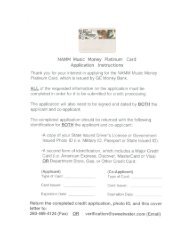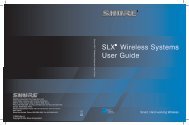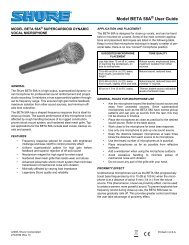Create successful ePaper yourself
Turn your PDF publications into a flip-book with our unique Google optimized e-Paper software.
Effects List<br />
14: INFINITE PHASER<br />
A phaser that continues raising/lowering the frequency at which the<br />
sound is modulated.<br />
fig.MFX-14<br />
L in<br />
R in<br />
Parameter Range Explanation<br />
Mode 1, 2, 3, 4<br />
Speed -100– +100<br />
Higher values will produce a<br />
deeper phaser effect.<br />
Speed at which to raise or lower<br />
the frequency at which the sound<br />
is modulated<br />
(+: upward / -: downward)<br />
Resonance 0–127 Amount of feedback<br />
Mix 0–127<br />
Volume of the phase-shifted<br />
sound<br />
Pan L64–63R Panning of the output sound<br />
Low Gain<br />
High Gain<br />
Infinite Phaser<br />
-15– +15 dB<br />
-15– +15 dB<br />
2-Band EQ<br />
Level 0–127 Output volume<br />
L out<br />
Pan L<br />
Pan R<br />
R out<br />
Amount of boost/cut for the lowfrequency<br />
range<br />
Amount of boost/cut for the highfrequency<br />
range<br />
16: STEP RING MODULATOR<br />
This is a ring modulator that uses a 16-step sequence to vary the<br />
frequency at which modulation is applied.<br />
fig.MFX-16<br />
L in<br />
R in<br />
Parameter Range Explanation<br />
Step 01–16 0–127<br />
Rate<br />
Attack 0–127<br />
Low Gain<br />
High Gain<br />
Step Ring Mod<br />
Step Ring Mod<br />
0.05–10.00 Hz, note<br />
-15– +15 dB<br />
-15– +15 dB<br />
Balance D100:0W–D0:100W<br />
2-Band EQ<br />
2-Band EQ<br />
Level 0–127 Output volume<br />
L out<br />
R out<br />
Frequency of ring modulation at<br />
each step<br />
Rate at which the 16-step sequence<br />
will cycle<br />
Speed at which the modulation frequency<br />
changes between steps<br />
Amount of boost/cut for the lowfrequency<br />
range<br />
Amount of boost/cut for the highfrequency<br />
range<br />
Volume balance of the original<br />
sound (D) and effect sound (W)<br />
15: RING MODULATOR<br />
This is an effect that applies amplitude modulation (AM) to the input<br />
signal, producing bell-like sounds. You can also change the<br />
modulation frequency in response to changes in the volume of the<br />
sound sent into the effect.<br />
fig.MFX-15<br />
L in<br />
R in<br />
Parameter Value Description<br />
Frequency 0–127<br />
Sens 0–127<br />
Polarity<br />
UP, DOWN<br />
Adjusts the frequency at which modulation is<br />
applied.<br />
Adjusts the amount of frequency modulation<br />
applied.<br />
Determines whether the frequency modulation<br />
moves towards higher frequencies (UP)<br />
or lower frequencies (DOWN).<br />
Low Gain -15– +15 dB Gain of the low frequency range<br />
High Gain -15– +15 dB Gain of the high frequency range<br />
Balance<br />
Ring Mod<br />
Ring Mod<br />
D100:0W–<br />
D0:100W<br />
2-Band EQ<br />
2-Band EQ<br />
Level 0–127 Output level<br />
L out<br />
R out<br />
Volume balance between the direct sound<br />
(D) and the effect sound (W)<br />
17: TREMOLO<br />
Cyclically modulates the volume to add tremolo effect to the sound.<br />
fig.MFX-17a<br />
L in<br />
R in<br />
Parameter Value Description<br />
Mod Wave<br />
Tremolo<br />
Tremolo<br />
TRI, SQR, SIN, SAW1,<br />
SAW2<br />
SAW1<br />
2-Band EQ<br />
2-Band EQ<br />
Modulation Wave<br />
TRI: triangle wave<br />
SQR: square wave<br />
SIN: sine wave<br />
SAW1/2: sawtooth wave<br />
SAW2<br />
Rate 0.05–10.00 Hz, note Frequency of the change<br />
Depth 0–127 Depth to which the effect is applied<br />
Low Gain -15– +15 dB Gain of the low range<br />
High Gain -15– +15 dB Gain of the high range<br />
Level 0–127 Output Level<br />
L out<br />
R out<br />
62
















